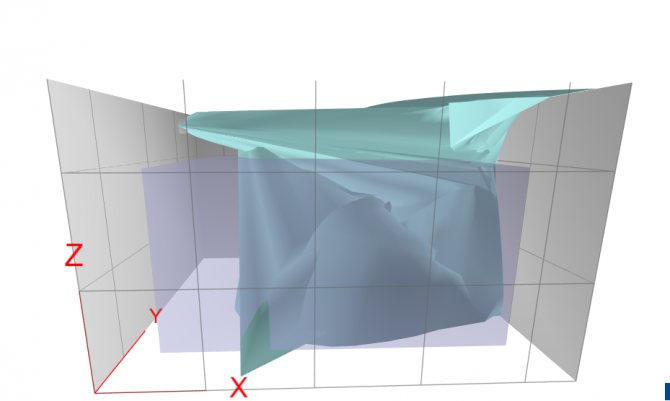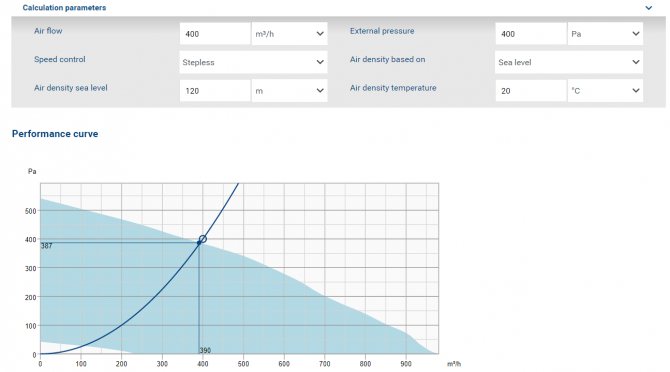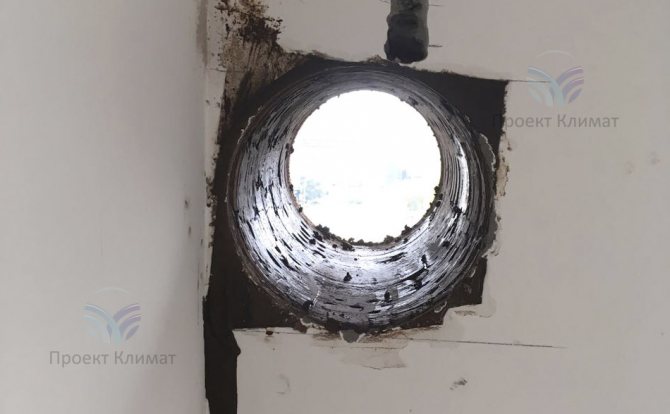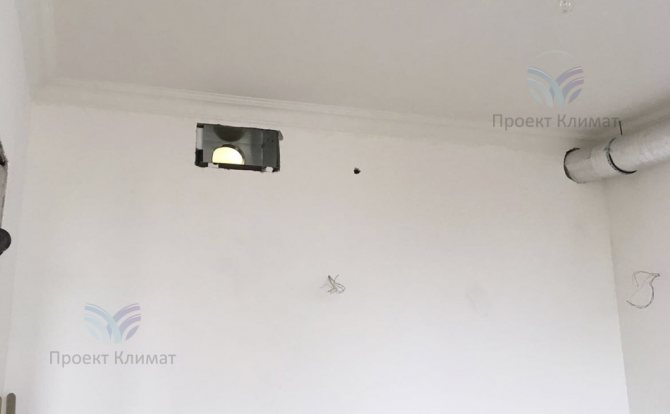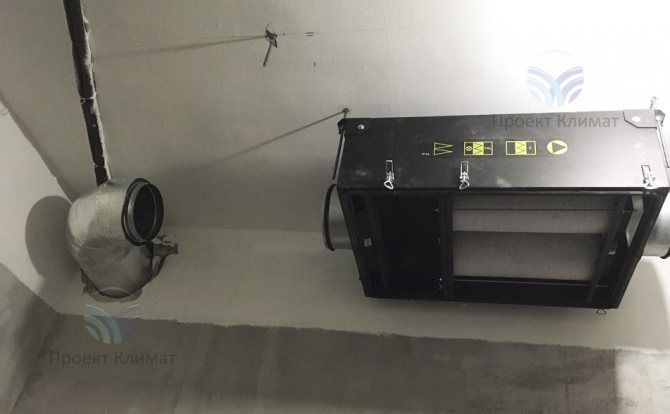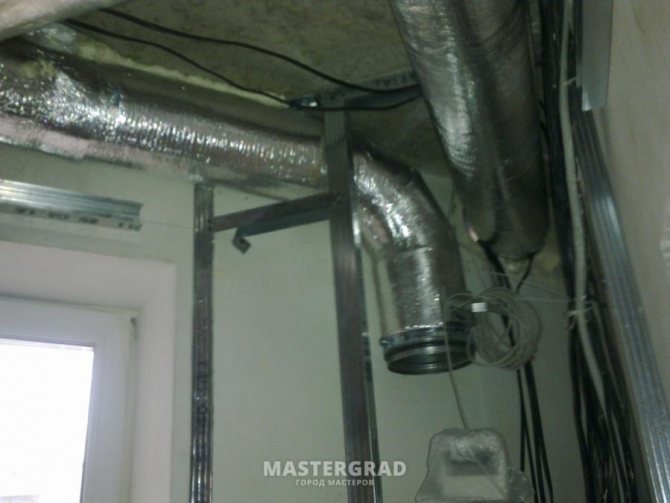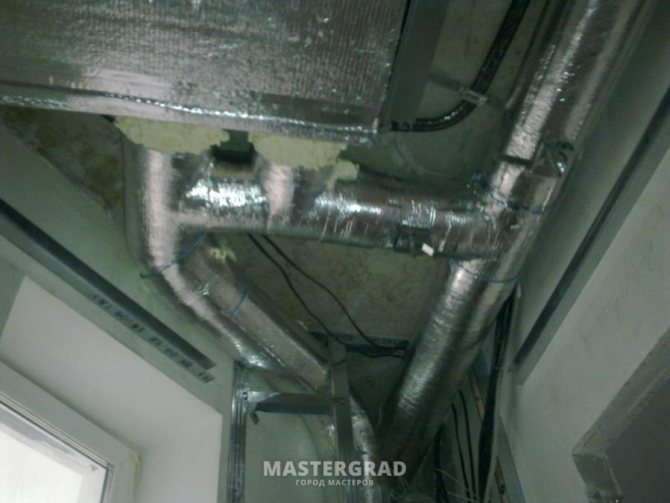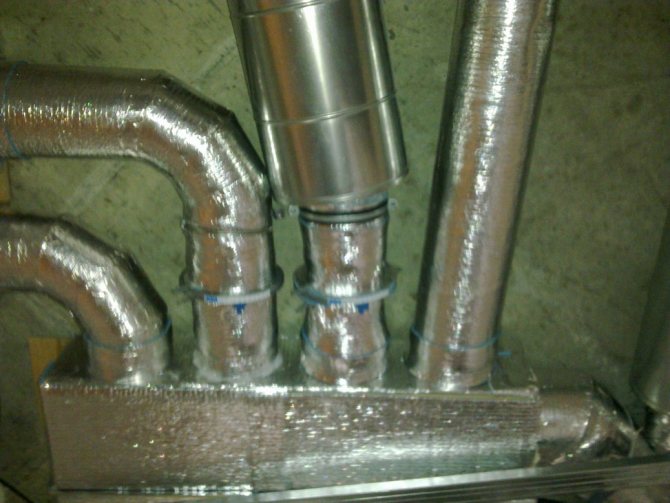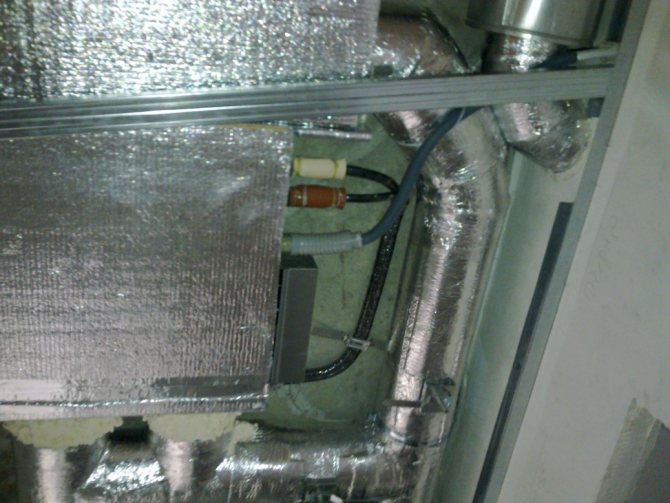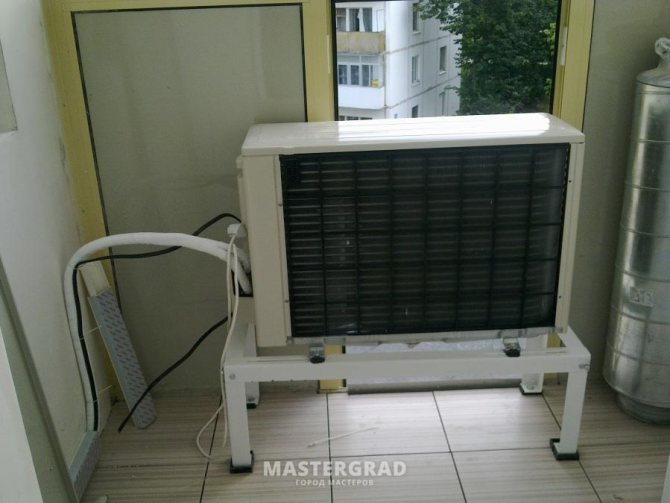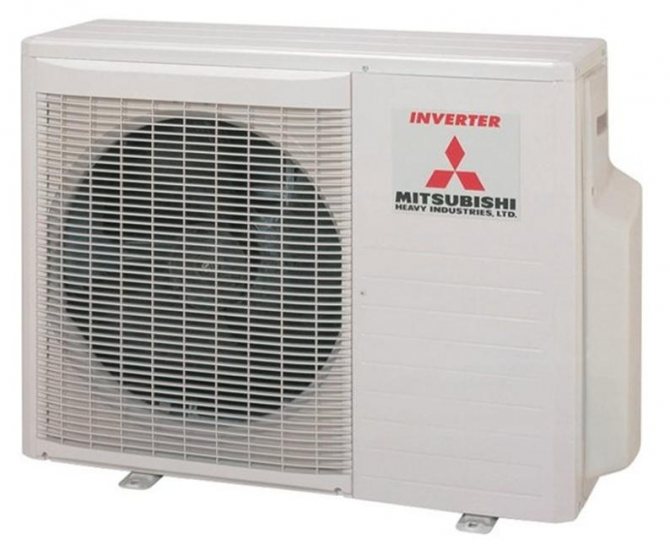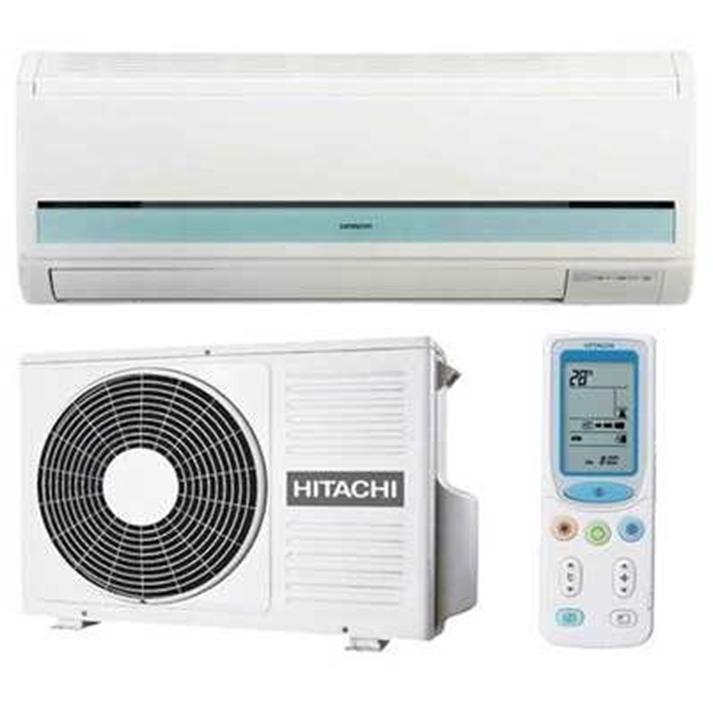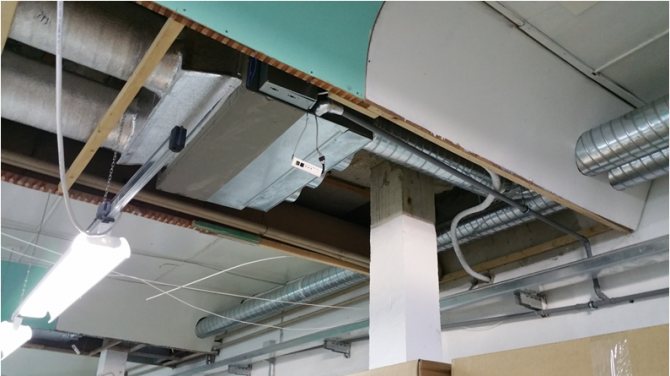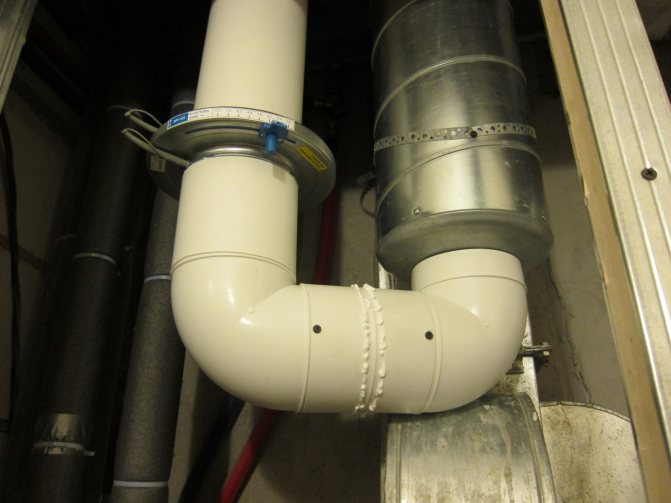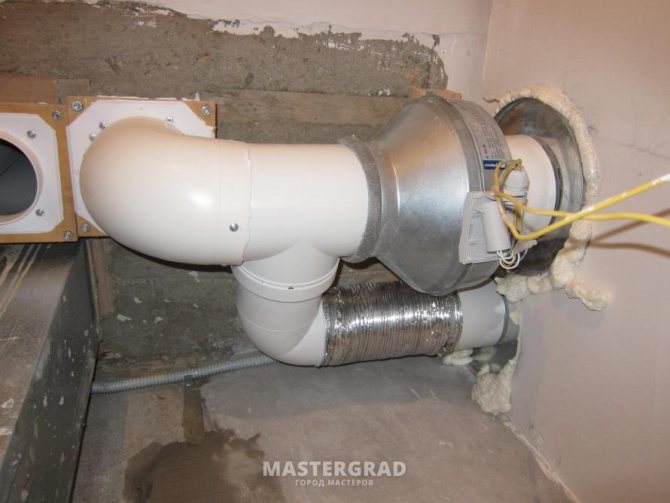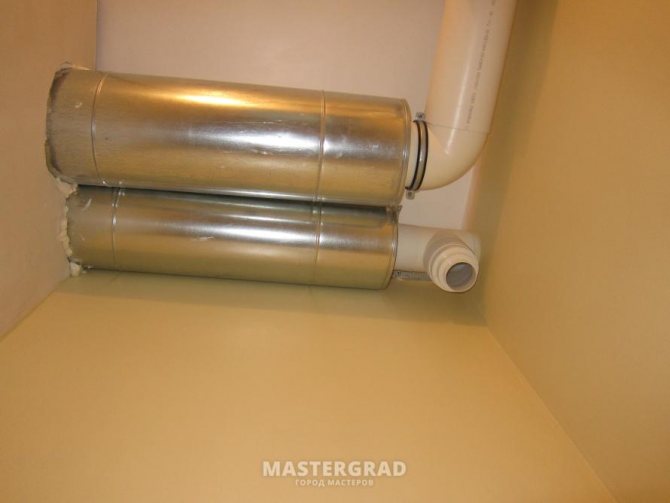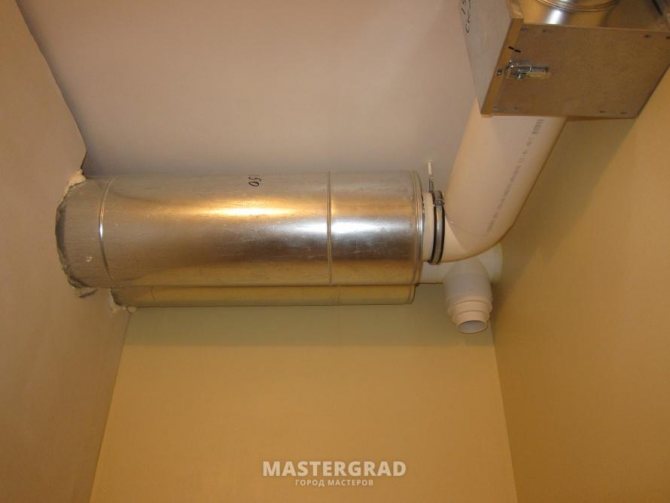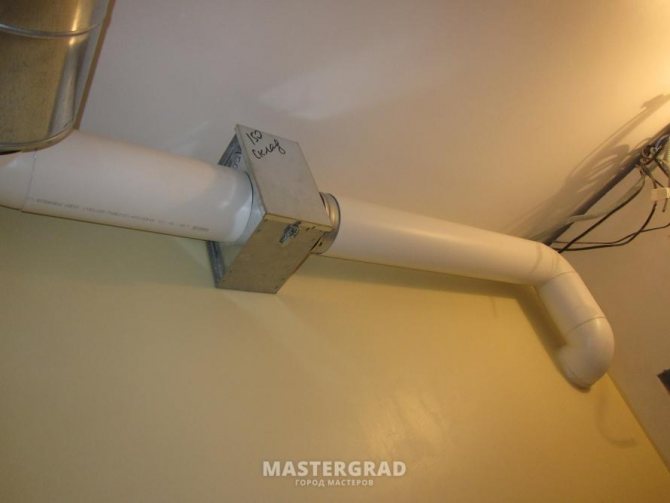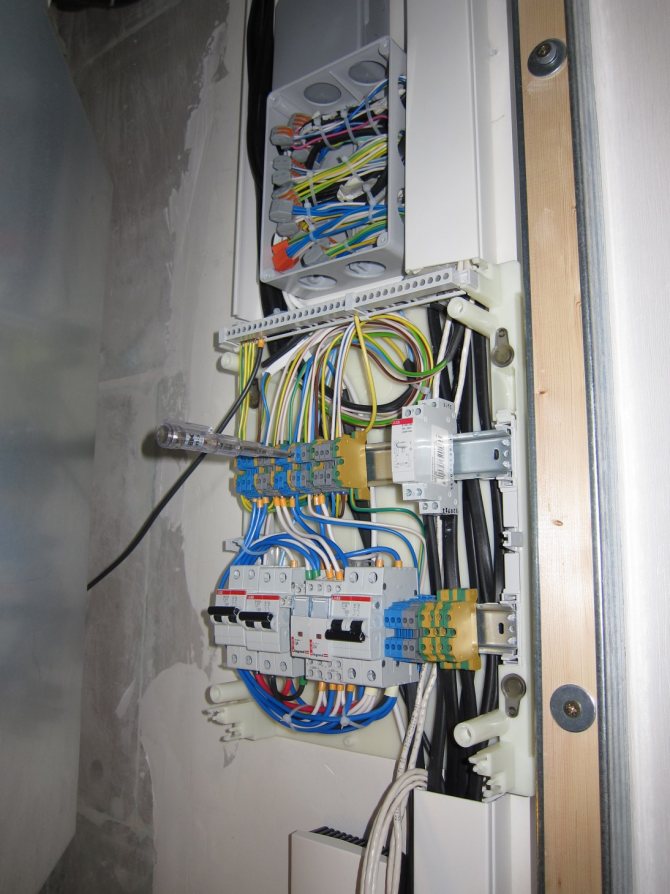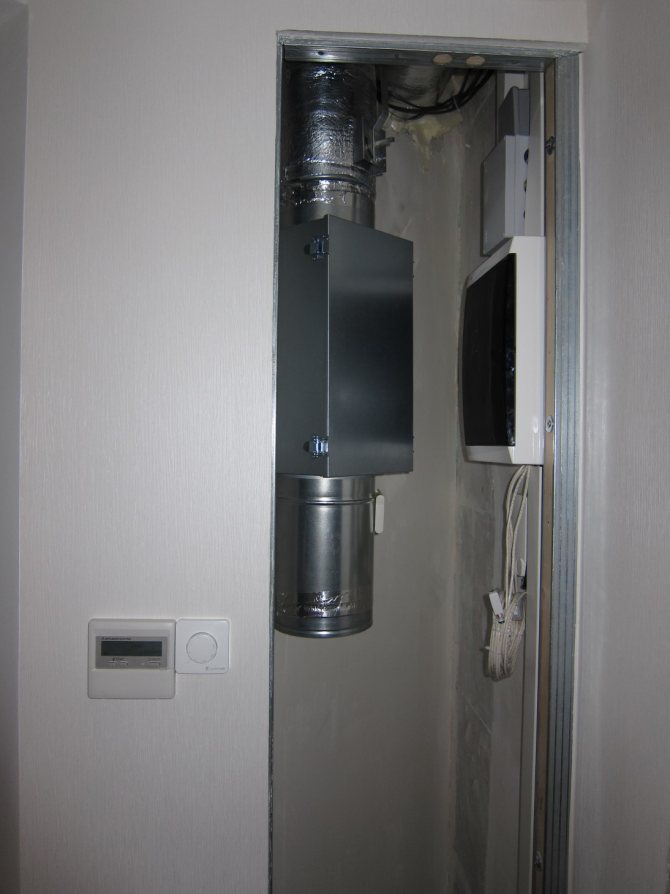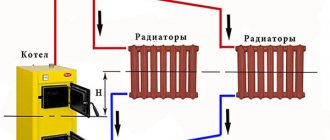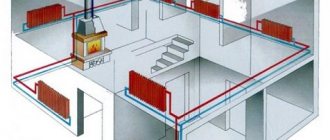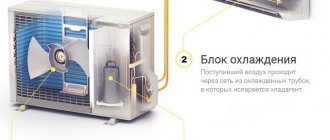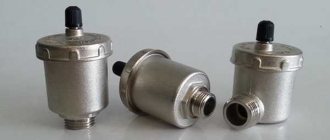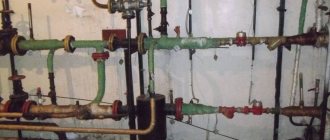Varieties of air conditioners with forced ventilation
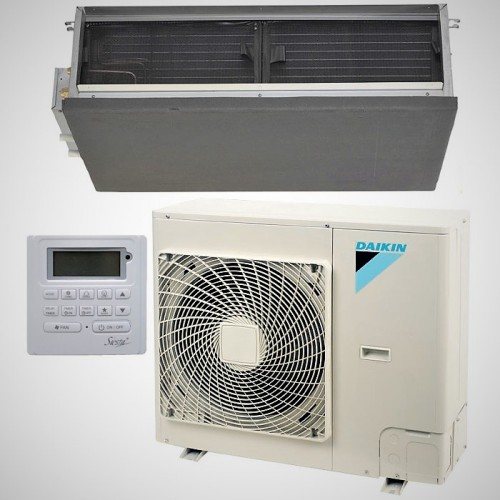
It has not yet been possible to combine the two functions of air preparation in full mode. The very best systems can only use the air supply from the street for 30% of the total capacity. At the same time, the air conditioner becomes much more complicated and the price rises.
For houses and apartments, only single-block air conditioners, of various modifications, split systems can be used. They serve to ensure the regime on an area not exceeding 100 m2. We will not consider cassette and column air conditioners.
Duct air conditioner with fresh air supply
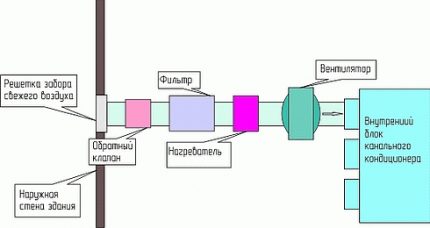

The device of the channel system is two-module. One compressor-condensing unit is located outside the perimeter, the evaporative unit is located inside the premises. They are connected to each other by copper tubes with freon and electrical wiring. The evaporating unit can be hidden in the cladding of the room. Air conditioners with the function of inflow of fresh air from the street produce air exchange into the room for 2-3 hours. Physiologically, the air becomes healthy, oxygenated. These air conditioners include systems from Daikin “Ururu Sarara”. Hitachi and Haier created their models with fresh air.
The technology for purifying and mixing air streams is complex. In a special block outside the perimeter, the air taken from the street passes through a manganese catalyst, adsorption of impurities, including odors, occurs. There is a filter at the entrance to the air conditioning system, which retains small debris, insects and other external dirt. After that, the gas streams are mixed and passed through a photocatalytic filter, where they are biologically disinfected. Clean air is enriched with vitamins and hyaluronic acid. The healing product is delivered to the premises.
Types of supply air conditioners
An air conditioner capable of supplying fresh air to a room differs from a conventional air conditioner by the presence of a special air duct, the design of which may be different.
Membrane
Air conditioners with a membrane-type air duct are not widely used due to a rather high cost (from 50 thousand rubles) and a complex installation system. The natural oxygen level in the room is maintained due to the fact that the membrane, which controls the operation of the air channel, has an uneven flow capacity. Moreover, oxygen molecules penetrate through it several times better than molecules of any other gases.


Installation of a modular climate system with fresh air supply
Modular system
Allows you to retrofit an existing air conditioner with a recuperator with an air duct. Structurally, the device is a separate external unit with small duct tubes. It is installed next to the air conditioner. In principle, this device resembles a small hood. Due to the fact that the system has limited air exchange capabilities (up to 20 cubic meters per hour), it has practically disappeared from the market.
According to SNiP 41-01-2003 "Heating, Ventilation and Air Conditioning", the minimum outdoor air consumption in the room is calculated on the basis that one person (depending on the ventilation system) accounts for 30 to 60 cubic meters. m. of air per hour.
Modification of the outdoor unit of the air conditioner
Modification of the external block of an existing air conditioner is the most optimal option to provide the required amount of supply air to the room. It provides for the placement of ventilation and cooling units in the case of an external device.Air supply is carried out through the indoor unit of the air conditioner, which is connected with the air duct to the ventilation module. At the same time, the modified air conditioner provides its supply in an amount of up to 32 cubic meters. per hour, which also does not fully comply with the requirements of the current regulatory documents. The price of such units is at least 140 thousand rubles, which significantly limits their use in everyday life.
Among air conditioners with mixed air, duct systems are the most effective, in which the volume of fresh air flow takes up to 25% of the total. However, these air conditioners are large and complex installation system, so they are rarely installed in apartments.
Duct air conditioner with fresh air admixture


The apartments use multi-split systems. They represent an installation with one unit placed outdoors, there can be 2-4 indoor modules. The system is equipped with an additional device for preparing air from the street. In such air conditioners, the intake of fresh air does not exceed 10% of the total volume in the circulation system. A specialist can install and correctly calculate a multisystem. At all exit points, the air parameters will be the same. This is the main disadvantage of a multipoint split system. More than 4 sampling points are not provided, because it is difficult to balance such a system in terms of performance.
A split-system with a wall-mounted indoor unit operates using a mixture of air from the street. But at the same time, the external unit of the air conditioner is modified, a fan and a mixing chamber are used. An air preparation unit is installed near the perimeter, providing winter heating and a coarse mesh for debris and living creatures.
Ventilation and duct air conditioning of a three-room apartment
The most common type of object:
- ventilation is supplemented by an air purification system and is responsible for the quality of this very air: purity and oxygen content, humidity
- air conditioning provides temperature control and far from only cooling: heating is also very effective in the off-season and even at negative temperatures overboard
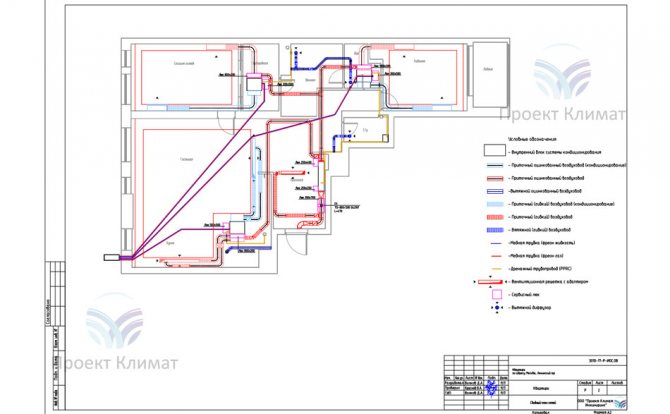

Summary plan of ventilation, air conditioning and humidification systems
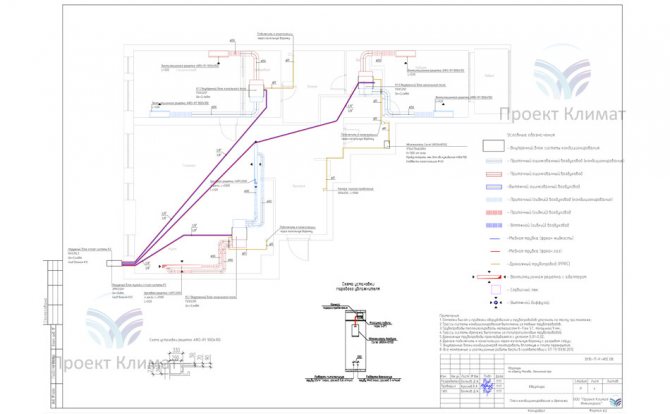

Section of the project dedicated to the implementation of ducted air conditioners
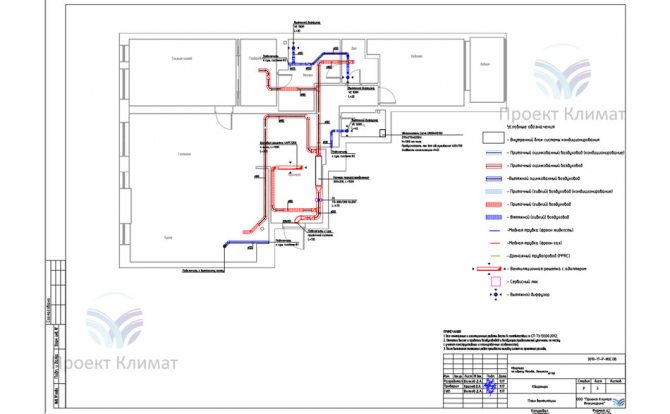

Plan for creating fresh air ventilation in a city apartment
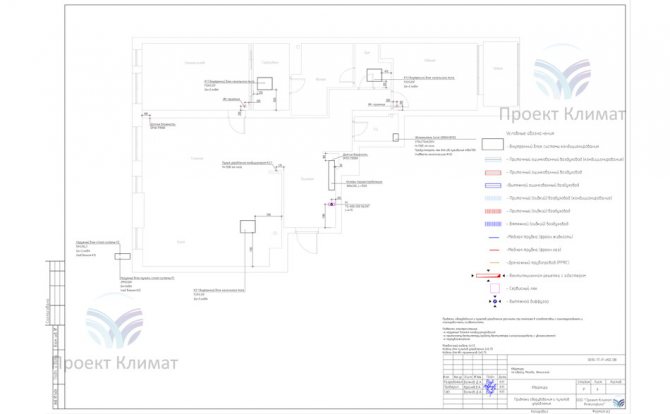

Binding location to the plan of service hatches for system maintenance
This is due to the convenience of combining these systems: both require space for ductwork. Moreover, in this case, as in many others, these systems are combined! The air duct of the air handling unit is connected to the adapter of the duct air conditioner. Those. this scheme assumes the supply of fresh air by the air conditioner. Already cleaned and heated or cooled.
The customer made the absolutely right choice by choosing the Japanese Mitsubishi SEZ-M series air conditioner. Mitsubishi series inverter duct air conditioners are used in 80% of objects due to their quietness and low height. For these two parameters, when choosing a duct air conditioner for an apartment, customers choose this series!
As the heart of ventilation - a Komfovent air handling unit of the Domekt series. And this is an exceptionally correct decision: I saved money on the manufacturer (a Russian brand, but it shows itself very, very worthy at more than one dozen of our facilities), but I took the system with heat recovery for the saved system!
Recuperation allows you to save up to 85% of the heat of the exhaust air by transferring it to the supplied air. These are significant savings in both heating and cooling!
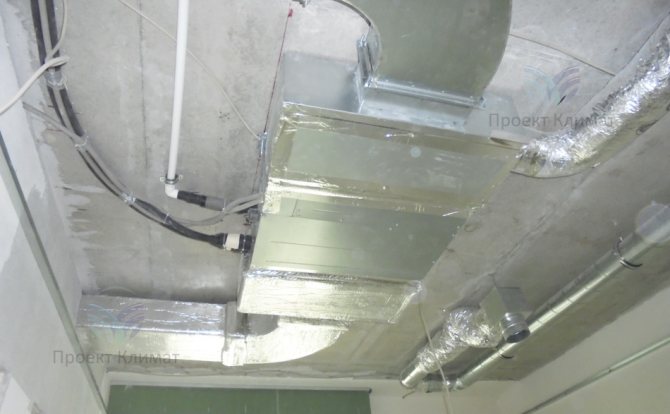

The air duct of the ventilation system is connected to the side of the air conditioner
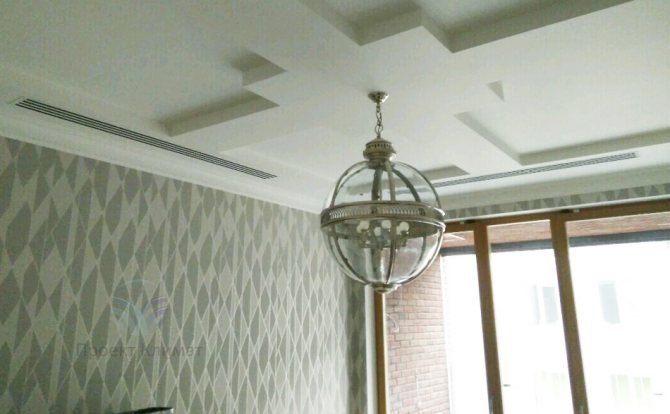

The result of the installation of duct air conditioners and ventilation in the apartment
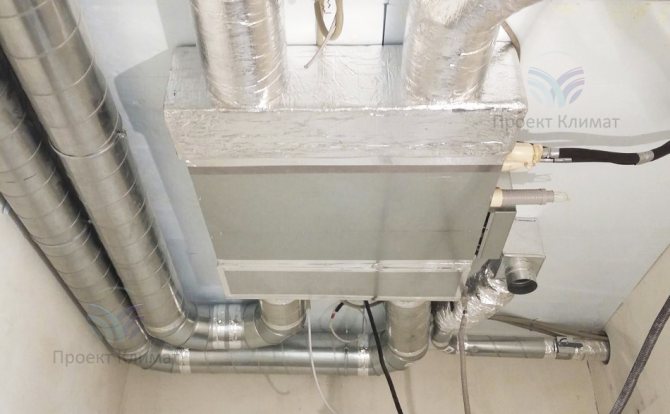

Duct air conditioner. Right - adapter for ventilation diffuser
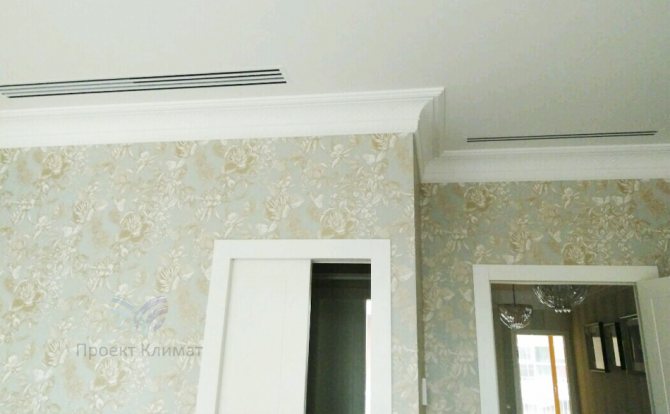

Duct air conditioning of the apartment after the delivery of the object to the customer
Air conditioner that takes air from the street
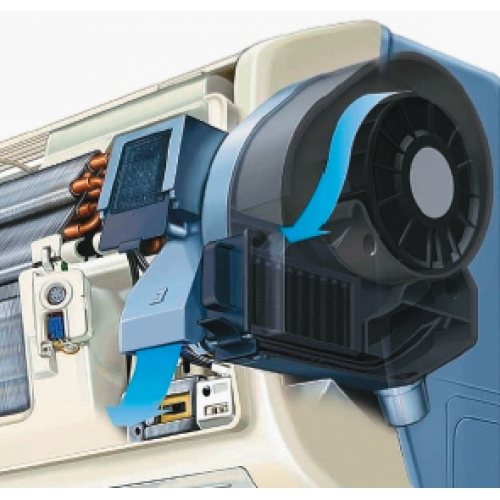

The channel split system uses the supply circuits most competently. Does this air conditioner take air from the street? One remote unit is located outside the circuit, the evaporators are connected to it by piping, installed in a suspended ceiling or false wall. An outdoor air preparation unit is used, which is supplied to the system in several places. The condition is that there is enough space behind a wall or under a ceiling to accommodate the equipment. The system is programmable, regulation is carried out by an electronic unit. The unit for preparing the air flow from the street and the duct air conditioner have different control panels. The addition of fresh air can be 30%. As a result of the renewal, the balance of carbon dioxide and oxygen content changes.
Split systems with supply ventilation function
Conventional household air conditioners are unable to provide fresh air to living quarters with a disturbed natural ventilation system. Experts believe that one of the most popular ways to solve the problem is the use of split systems that are capable of operating in the supply ventilation mode. Compared to conventional or modified air conditioners, such systems have the following advantages:
- high power;
- noiseless operation;
- high performance;
- the presence of a variety of built-in devices;
- remote control.
In addition, a split system with fresh air supply has the ability not only to cool, but also to heat the room, which makes it possible to use it in the cold season.
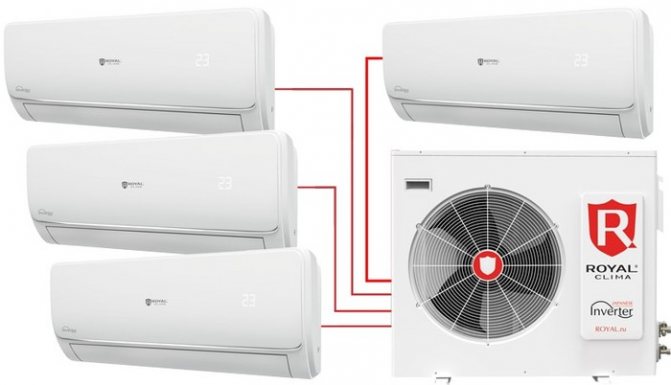

Multi-split air conditioning system
Often multi-room apartments and private houses are equipped with multi-split systems. They are used in cases where it is undesirable to install several outdoor units that can ruin the facade of any house. The structure of such systems includes 1 remote and from 2 to 4 indoor units. However, multisplit systems have a number of significant drawbacks, due to which they have not become widespread:
- complex installation;
- low reliability;
- insufficient performance;
- operation of the entire system in one mode, the same for all units (either heating or cooling).
To provide full ventilation of the premises, replacing the exhaust air with fresh air, only supply systems are capable, which by the principle of operation are similar to conventional split systems, but differ somewhat from them in design and installation method. They are built on the basis of recirculating channel air conditioners and are capable of supplying up to 160 cubic meters to the premises. m. of air per hour.
The device and principle of operation of a recirculating duct air conditioner
Structurally, a recirculating duct air conditioner with outdoor air intake consists of two blocks - external and internal.
The external block contains the main and auxiliary units and mechanisms: a condenser heat exchanger with a fan, a compressor, an automation system, measuring sensors, etc. It is installed on one of the outer walls of the building or in other convenient places, if possible protected from sunlight.
The indoor unit contains a minimum set of components: an evaporator heat exchanger and a fan blowing it, a temperature sensor, an air purification filter, etc. As a rule, it is built into a suspended ceiling, which is due to the need to supply air ducts to the unit.
A duct air conditioner with air ventilation operates as follows: air from one or several rooms is sucked in by the fan of the indoor unit and is fed through the air ducts to the condenser heat exchanger of the outdoor unit. Then it comes back through the air ducts.The main job of such an air conditioner is to process recirculated air coming from the premises, however, many models provide for the function of adding fresh air from the street. In this case, the volume of the latter is about 30% of the total air flow.
However, the duct air conditioner with air supply is also not able to fully provide oxygen supply to the premises. This is due to the fact that according to the current regulations, the air temperature should be within 14… 16 ° С.
To heat the supply streams in the cold season, use a special heater, an air heater, which is part of the channel split systems with the supply ventilation function.
Duct split system with supply ventilation function
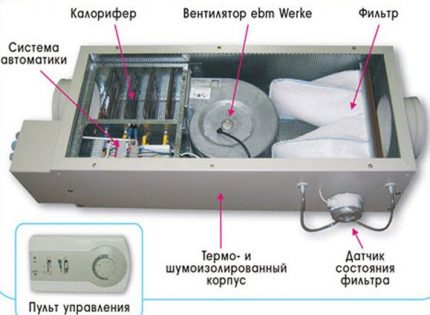

Duct air conditioner with heater
Structurally, a split system with supply ventilation consists of:
- indoor unit, which includes a fan, a heat exchanger with a fan, a filter and a control module; an additional heater is connected to the unit, made in a separate housing;
- the outdoor unit, which houses the mixing chamber, compressor with air condenser fan, heat pump and microprocessor control module.
The outdoor unit is located on the street. It can also be installed indoors, but for this the unit must be equipped with a centrifugal fan. The external and internal blocks are connected to each other by a thin freon pipeline. The indoor unit is installed behind a false ceiling or in a special box.
During operation, outside air enters the mixing chamber through a thermally insulated air duct and mixes there with the air coming from the room. Then the air mixture passes through the filter and is supplied to the indoor unit, where it is processed according to a given program (heating, cooling, etc.) and supplied to the premises.
A microprocessor control module controls the operation of the entire system, which maintains a comfortable temperature in the premises throughout the year:
- In the summer, it provides the necessary cooling.
- In spring and autumn he heats up air masses using a heat pump.
- In the cold season, when the thermometer drops below 0 ° C, the heater turns on. At the same time, the control module provides smooth regulation of its power, which allows maintaining the set temperature in the room.
Air conditioners with fresh air supply for an apartment
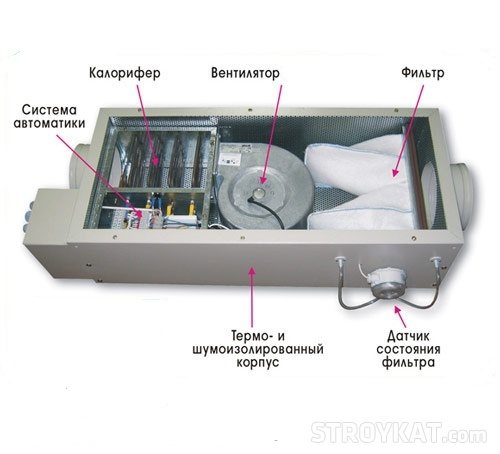

Another type of split systems is the supply and exhaust air conditioner in the product line from Hitachi, they are not very powerful, the air exchange reaches only 8 m 3 per hour, but this amount is enough for a bedroom. The Hitachi RAS-10JH2 air conditioner is an example of a supply-and-exhaust split system. The model has an inverter compressor, 2 pipes are used - supply and exhaust. The air is removed forcibly, fresh air from the street can be heated. The control panel has separate options for supplying air from the street and removing waste. One mode is selected, then the system is adjusted to an equilibrium state.
Haier offers 2 models of premium air conditioners: Aqua Super Match AS09QS2ERA and LIGHTERA HSU-09HNF03 / R2 (DB). In these units, the supply air system is an additional option. But having bought the equipment, it is possible to provide air renewal at a rate of 25 m 3 / hour. Both models of air conditioners have a built-in function for mixing air from the street. For this, the external block has a forced-air fan and a mixing chamber for two gas streams. The flexible outdoor air hose can be introduced directly into the room in one way or another.
Installation steps
Installation of a duct air conditioner with fresh air supply for an apartment begins with choosing a suitable place for placing an outdoor unit. In this case, it is advisable to select one that is in the shade.Residents of apartments are advised to place the module closer to the balcony in order to facilitate the maintenance of the device. It is also necessary to observe the distance between the inner and outer parts, the manufacturer specifies the specific parameters in the instructions.
The installation process itself is as follows:
- Where the interior will be located, it is necessary to drill a hole with a diameter of at least 8 cm, which will be used for laying communications.
- The outdoor unit is installed on the wall, where it is fixed with brackets, while the box must be placed strictly horizontally.
- The indoor unit is installed in the room. It is best to mount it to a ceiling or wall to avoid vibrations. If this is not possible, you will have to additionally use vibration dampers.
- After that, you can conduct electricity to the block. For this, a separate wire is used that connects the batteries in the system and the distribution board.
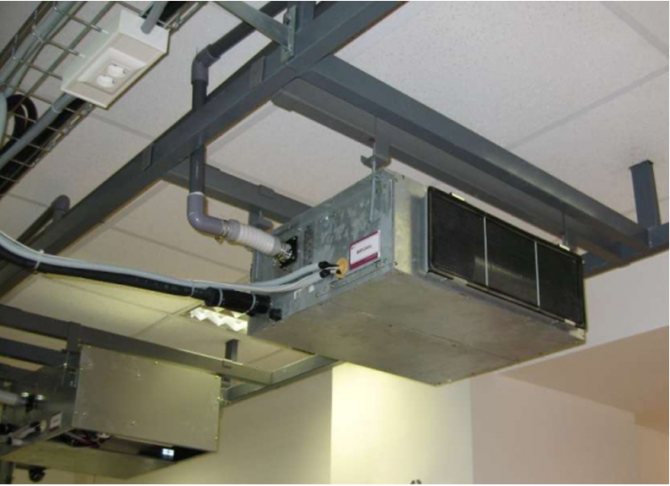

The outdoor unit is mounted on the wall, where it is fixed with brackets
Freon tubes will also need to be installed in order for the system to function normally:
- This will require a pair of copper pipes, which are cut using a special tool - a pipe cutter.
- Next, the workpieces need to be bent using a pipe bender. It is important to use a tool to perform this step, as without it, the tubes can deform and crack, which means they will lose their tightness and be unusable.
- Nozzles for thermal insulation are attached to the tubes, and flanges are installed at the edges.
- After that, rolling is carried out. It is advisable to use a torque wrench to tighten the nuts so that the products do not crack.
- The ends of the tubes are screwed in with flanges. It is necessary to tighten the fasteners properly to ensure a tightness in the system.
The external part of the system, which is located outdoors, is usually fixed with special fastening clamps or placed in a protective box. After installation, it is necessary to carry out a vacuumization so that all excess moisture from the inside can evaporate. Then a cooler is launched into the system, while controlling the pressure level. The air conditioner is started for testing, and if everything is in order, the air ducts are connected to it.
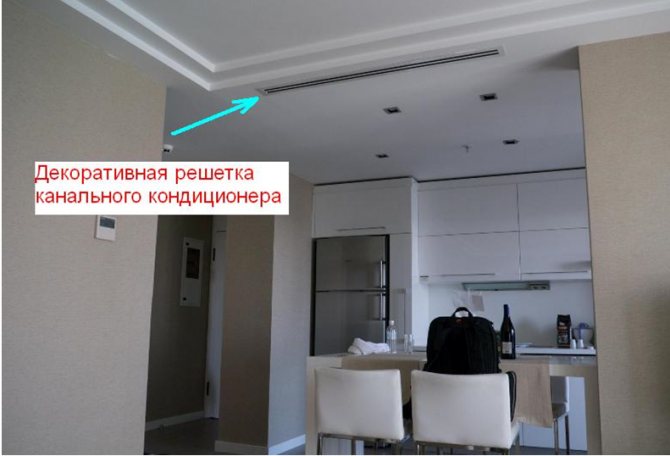

Decorative grille for duct air conditioner
Rules for placing block air conditioners with air supply from the street
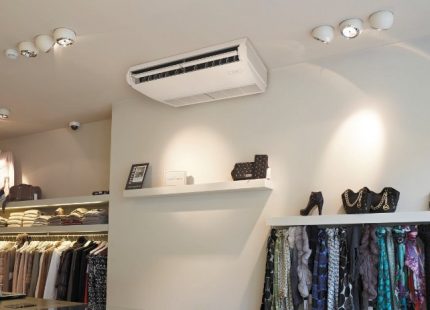

When installing the evaporators on the ceiling, it is important that the cool air flow does not reach the area where people are located. Therefore, narrow slotted blinds are used. The higher the ceiling, the better the counter gas flows are averaged. In a split duct system, the distance between the normal and false ceilings is not less than 25 cm. The same applies to the false walls behind which the channels pass.
In any case, duct air conditioners or split systems with fresh air inflow will cost more at a price, and it is more difficult to operate than a separate supply and exhaust system and air conditioner. Devices 2 in 1, naturally, have somewhat truncated capabilities.
Fresh air conditioner
Similar articles on the site:
- Air conditioner functions
- Air conditioners rating 2017
- How to choose a split system
- Air conditioner power
Ventilation grates
To distribute air around the room, I used adjustable (vertically and horizontally) supply ventilation grilles Systemair NOVA-A-2-2-300 × 100.
It is better to order the grilles complete with a regulator - it is very convenient to regulate the flow or, for example, turn off one of the rooms.
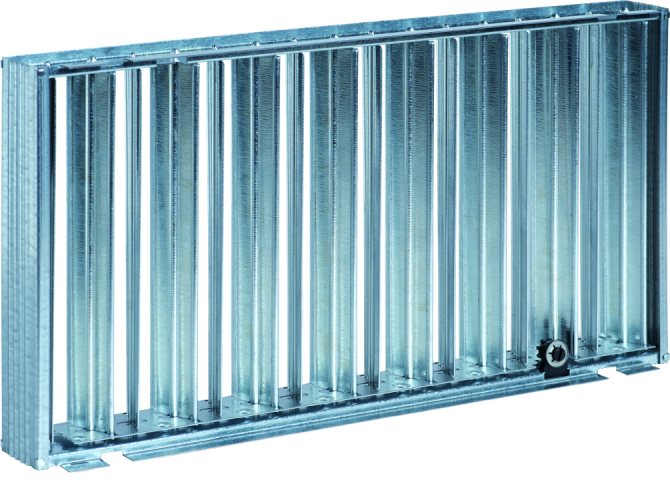

The site has an excellent calculator for checking the parameters of each of the components. For example, for NOVA-A-2-2-300 × 100.
The main advantage of such adjustable grilles is that you can create an air jet that sticks to the ceiling, which "breaks through the whole room."
For example, this is how the distribution of the air flow in my room looks like (4.5 x 3.5 m, ceiling height 2.7, the location of the grill 15 cm from the ceiling in the corner of the room) with different air flow rates (room temperature 20 C, supply temperature 20 C):
- 60 (m3 / h) and terminal flow rate 0.1 m / s

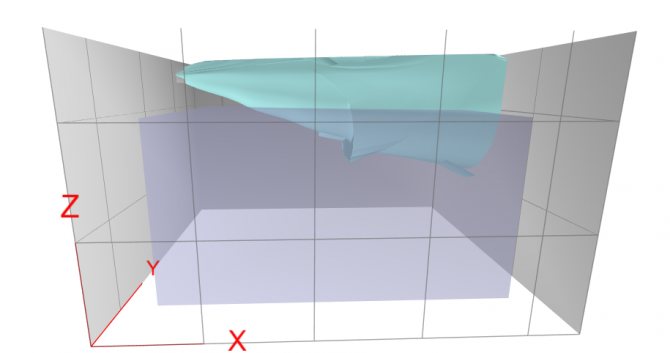
- 120 (m3 / h) and terminal flow rate 0.2 m / s

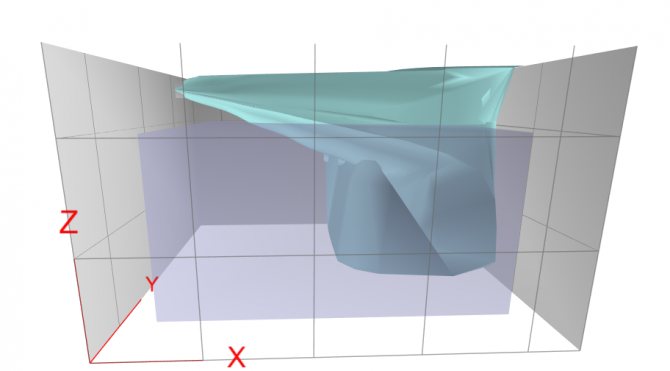
- 250 (m3 / h) and terminal flow rate 0.3 m / s

